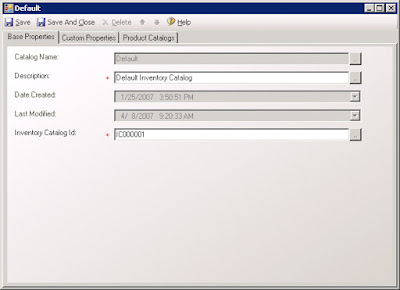Creating an Inventory Catalog
The process of creating an inventory catalog is
straightforward and relatively simple. Inventory catalogs are created through
the Catalog Manager, and then product catalogs are mapped to them. A product catalog can only be mapped to one
inventory catalog, but an inventory catalog can have many product catalogs.
The pro golf shop requires only one inventory
catalog, but both the base and virtual product catalogs must be mapped to the
inventory catalog. The reason both
catalogs are mapped is that inventory quantity must be allocated for both the
online retail customers and the trading partners.
A default inventory catalog already exists, called
Default. This catalog cannot be deleted,
and will be used for the golf pro shop inventory catalog.
To create the inventory catalog, you can use the
Catalog Manager.
1. Click Start > All Programs >
Microsoft Commerce Server > Catalog Manager.
2. Under the View pane, click Inventory
Catalogs. After you have selected the
inventory catalogs view, the Task pane will update to show tasks specific to
inventory catalogs.
3. Double-click the Default inventory
catalog. This will open the inventory
catalog properties window.
4. The Base Properties tab is selected by
default (Figure 4-7). Since we added the
Inventory Catalog Id property definition to the Inventory Catalog Metadata, and
it is a required property, you must specify a value. Note that this property is on the base
properties tab, rather than the custom properties tab. This is because the Display as Base Property
value was set to True on the property definition. If it had been set to False, this property
would be on the custom properties tab.
Figure 4-7
5. Click the Product Catalogs tab (Figure 4-8). By default, no product catalogs have been added to the default inventory catalog. To add our catalogs, click the Add Catalog button.
Figure 4-8
6. The Product Catalogs screen will list all
the available product catalogs that can be added to this inventory catalog
(Figure 4-9). Since a product catalog
can only be mapped to one inventory catalog only unmapped product catalogs are
displayed. Either select both the
ProShopCatalog and TradingPartnerCatalog, or click the Select All button. Click the OK button to continue.
Figure 4-9
7. Click the Save And Close button to
finish.
Once a product catalog has been mapped to an
inventory catalog, inventory data can now be associated to your products or
product variants.
Adding Inventory to SKUs
Now that the product catalogs have been mapped to
an inventory catalog, inventory data must be added to the SKUs. The SKU can either be a product or product
variant, depending on how the catalog was defined. If a Variant Id was specified when the
product catalog was created then inventory information resides at the product
variant level. If a Variant Id was not
specified when the product catalog was created then the inventory information
resides at the product level.
The golf pro shop has product variants, and
consequently inventory information must be entered for each of the product
variants. To add inventory information
to the pro shop product variants, you must use the Catalog Manager.
1. Click Start > All Programs >
Microsoft Commerce Server > Catalog Manager.
2. Under the View pane, click Catalogs. After you have selected the catalogs view,
the Catalogs tree view pane will display all the product catalogs.
3. In the Catalogs tree view pane, expand
the ProShopCatalog catalog, the Golf Clubs category, and select the Drivers
category.
4. Double-click the “Calloway FT-5 Driver”
from the Category and Product Details list.
This will open the product properties screen.
5. Now that the product catalog has been
mapped to an inventory catalog, a new tab called Variant Inventory Properties
is. Select the Variant Inventory
Properties tab.
6.
On the Variant Inventory Property
tab (Figure 4-10) you will see a grid that contains all the variants in rows
and all the inventory SKU metadata as columns (Figure 4-10). For a non-product variant catalog this tab is
called Inventory Properties (Figure 4-11).
By default four inventory SKU properties are required: Status, Onhand
Quanitity, Stockout Threshold, and Warehouse Location (the property definition
you added to the inventory SKU metadata).
Enter values for each of the variants.
Make sure to set the status to Enabled, the onhand quantity greater than
0, and the stockout threshold to 1 (indicating that there must be at least one
SKU available to be considered in stock).
Figure 4-10
Figure 4-11
7.
Once all the inventory information
has been added to the product variants, click Save And Close to finish.
Now that inventory exists for the product variants
on the golf pro shop, you could actually begin to sell your products online
(assuming you have already developed the Web site). Since inventory exists for products, such as
golf club drivers, they are considered in stock and can be purchased. For most online Web sites, however, you will
probably want to turn on some special inventory handling, such as inventory
back-ordering and pre-ordering.




